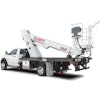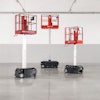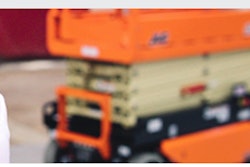The safe planning of MCWP installation should start long before the machine is delivered on site. First, the correct definition of project and user needs is essential to specify the optimal piece of equipment needed to do the job. Next, it is necessary to plan all the details for the erection, use and dismantling processes. Both tasks, definition of the right equipment, and planning of the different stages of use, are absolutely crucial.
No one should be responsible for specifying MCWPs, or planning an installation, or altering an installation, unless they are competent in this work. A competent person should be appointed by the supplier to act on his behalf to have overall control of the specification, installation planning, erection and dismantling of MCWPs. In selecting an MCWP and planning the installation, this supplier- appointed person should refer to the MCWP operating specifications and installation instructions provided by the manufacturer.
The supplier-appointed person should consult with the management-appointed person of the user organization for a clear understanding of the intended application, the work load and any site-based restrictions or special requirements.
A site survey is necessary and should include aspects such as the establishment of the primary purpose for which MCWPs will be used, determination of any additional requirements for the unit (like prevention of falling debris, inclined masts, etc), type of platform, maximum height of travel and length of work platform required and its configuration (single or twin mast, edge extensions etc), loading capacity and method of loading, access and egress of personnel and materials, ground/supporting base conditions (levels and load bearing capacity), area conditions around base and mast positions, tie-fixing-point strengths and fixing-point details on the structure.
Details gained during the site survey should be used to compile a clear written method statement describing the safe system of work for erection and dismantling. This should be a comprehensive, job-specific procedure for the work to be carried out, and should include such information, explanations, detail and diagrams that all concerned with the authorization, erection and dismantling are clear of their specific duties. It should also include or make reference to the risk assessments for all the work activities connected with the delivery, site handling, erection, use, dismantling and collection of MCWPs. This method statement should be issued and understood by all involved in the installation/dismantling of MCWPs.
How safety and training differ for different roles
Levels of training required for the roles involved in the planning and erection of a MCWP are:
Installers are in charge of the installation of a MCWP in all standard configurations indicated by the manufacturer; able to perform installation final appraisal and hand-over procedure.
Advanced Installers are in charge of the installation of a MCWP in all configurations including special configurations and tailor-made projects. They must be able to perform installation final appraisal, hand-over procedure and the MCWP Thorough Examination. They must have the appropriate practical and theoretical knowledge and experience of the MCWP to be thoroughly examined as this will enable them to detect any defects or weaknesses and to assess their importance in relation to the safety and continued use of the lifting equipment.
Once the machine has been installed, and thoroughly examined, it can be used. Then next roles and level of training apply:
Operators are persons who have been trained to operate the MCWP, with full knowledge of the controls of the equipment and they are able to carry out pre-use/daily inspections and perform the emergency descent.
Demonstrators are persons, with full knowledge on the operating commands of the equipment, who are able to perform the emergency descent, carry out pre-use/daily and weekly inspections and ensure that these take place.
In addition, demonstrators are in charge of performing familiarization to users and trained operators.
What does training involve?
IPAF’s MCWP Training program is modular and according to the level the trainee wants to achieve (Operator, Demonstrator, Installer, Advanced Installer or Trainer). After each module completion, the instructor runs a written or practical test for that module. All courses have a practical assessment where trainees are asked to perform specific tasks to prove their practical knowledge and skills acquired during the course.
Training is crucial to avoid those hazards, and guarantee the safe and effective use of this wonderful type of access equipment that is the MCWP.
For more info, see www.ipaf.org/training



















